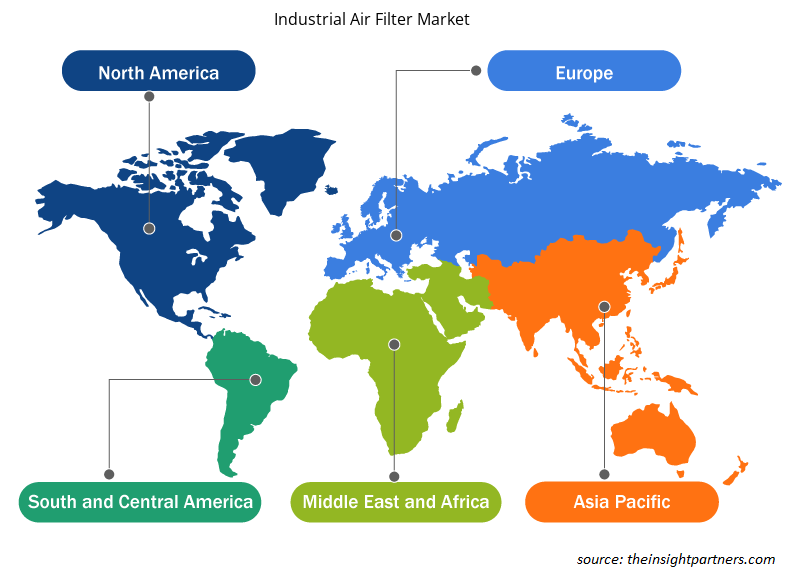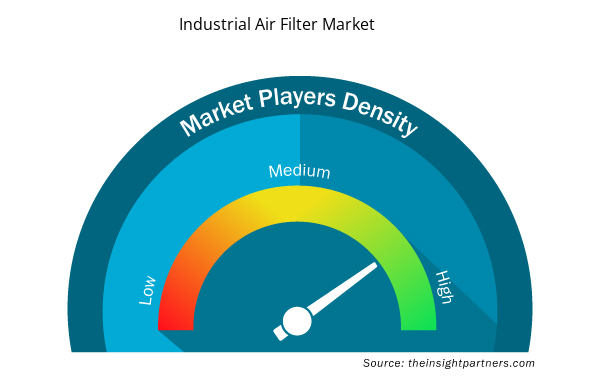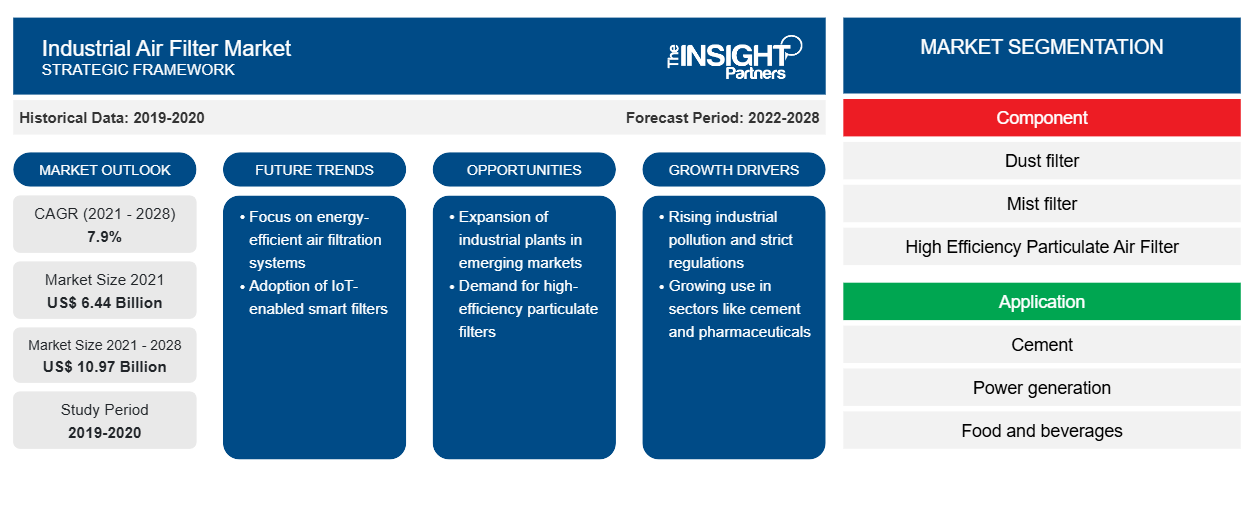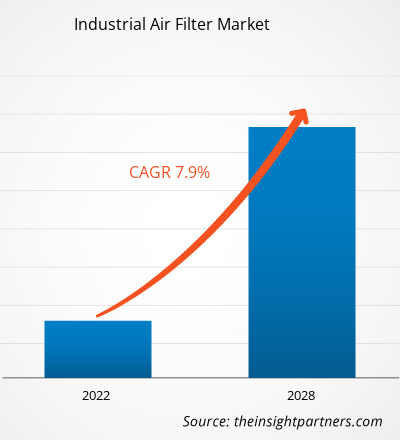[調査レポート] 産業用エアフィルター市場は、2021年の64億4,000万米ドルから2028年には109億7,000万米ドルに成長すると予想されており、2021年から2028年にかけて7.9%のCAGRで成長すると予測されています。
アナリストの視点:
産業用エアフィルター市場は近年大幅に成長し、拡大しています。これは、産業環境におけるエアフィルターシステムの需要を牽引するいくつかの重要な要因に起因しています。主な推進要因の 1 つは、世界中のさまざまなセクターで急速に工業化が進んでいることです。産業が拡大し、生産プロセスが強化されるにつれて、空気中の汚染物質と汚染物質が増加します。そのため、最適な空気の質を維持し、労働者の健康を守るために、効果的なエアフィルターシステムを実装する必要があります。市場の成長に貢献しているもう 1 つの重要な要因は、政府と環境機関による空気の質の基準と規制の厳格化です。これらの規制は、産業活動によって大気中に放出される排出物と汚染物質を最小限に抑えることを目的としています。その結果、産業界はこれらの厳格な基準に準拠するために、高度なエアフィルター技術に投資せざるを得なくなります。
さらに、空気の質の悪さが生産性、労働者の健康、全体的な業務効率に悪影響を及ぼすという認識が産業界の関係者の間で高まっています。産業用エアフィルターは、ほこり、煙、化学物質、アレルゲンなどの有害な粒子を空気から除去し、より健康的で安全な作業環境を作り出す上で重要な役割を果たします。産業用エアフィルター市場には、製造、自動車、製薬、食品加工、化学工場、電子機器など、さまざまな産業分野に対応するさまざまな製品が含まれています。これらのフィルターは、各業界の特定の要件に応じて、サイズ、効率、テクノロジーが異なります。
市場概要:
屋内と屋外の空気の質を高めるために、エアフィルターは空気中の不純物を減らしたり除去したりします。暖房、換気、空調システムには、空気中の異物を取り除く工業用エアフィルターが必要です。工業用エアフィルターは、プロセスで煙や汚染物質が発生するビジネスでは不可欠です。これらのフィルターは、花粉、ほこり、化学汚染物質などの汚染物質をろ過して、密閉された環境で室内空気質 (IAQ) を維持します。工業用エアフィルターは、汚染物質が工業機械に侵入するのを防ぎ、大きな異物による機械の損傷のリスクを軽減します。
要件に合わせてレポートをカスタマイズする
このレポートの一部、国レベルの分析、Excelデータパックなど、あらゆるレポートを無料でカスタマイズできます。また、スタートアップや大学向けのお得なオファーや割引もご利用いただけます。
- このレポートの主要な市場動向を入手してください。この無料サンプルには、市場動向から見積もりや予測に至るまでのデータ分析が含まれます。
市場の推進要因:
健康と安全に対する意識の高まりが産業用エアフィルター市場の成長を促進
産業現場における健康と安全に対する意識の高まりは、産業用エアフィルター市場の成長を促進する上で重要な役割を果たしています。組織や業界が空気の質が労働者の健康と安全に与える影響をより意識するようになるにつれて、清潔で健康的な屋内環境を作ることがより重視されるようになっています。この意識により、効果的な空気ろ過システムの需要が高まり、市場の成長が促進されます。組織は、空気の質が悪いと呼吸器系の問題、アレルギー、職業病につながる可能性があることを認識しており、従業員の健康を最優先しています。企業は、高品質の空気ろ過システムに投資することで、屋内の空気の質を改善し、従業員に安全な作業環境を提供することを目指しています。労働者の健康へのこの重点は、産業用エアフィルターの需要を促進し、市場の成長に貢献しています。
政府や規制機関は、厳格な労働安全衛生規制を課しています。これらの規制には、多くの場合、産業環境で許容可能な空気品質基準を維持するための特定の要件が含まれています。組織は、罰金や法的責任を回避するために、これらの規制に従わなければなりません。これらのコンプライアンス要件を満たす効果的な空気ろ過システムの需要が高まっており、市場の成長をさらに促進しています。清潔で健康的な屋内空気の質は、労働者の生産性と全体的な業務効率にも直接影響します。従業員がきれいな空気にさらされると、健康上の問題が減り、疲労が軽減され、集中力と注意力が向上します。これを認識し、組織は産業用空気フィルターに投資して従業員のパフォーマンスを最適化し、最終的に生産性と業務効率を向上させます。
さらに、従業員の健康と安全を優先する組織は、肯定的な評判とブランド イメージを構築できます。消費者、投資家、人材は、労働者の幸福と環境の持続可能性に取り組む企業を支持する傾向が高まっています。清潔で健康的な作業環境を提供する高度な空気ろ過システムに投資することで、企業は評判を高め、市場での競争優位性を獲得できます。産業環境における健康と安全に対する意識の高まりは、消費者の嗜好の変化も反映しています。消費者は、購入する製品と支援する企業について、より意識的になっています。消費者は、労働者の幸福と環境責任を優先する企業を好みます。したがって、産業用エア フィルターを通じて清潔で健康的な空気の質を提供することに取り組んでいる組織は、これらの消費者の嗜好に合わせることができ、市場で有利な立場に立つことができます。
セグメント分析:
製品に基づいて、産業用エアフィルター市場は、ダストフィルター、ミストフィルター、バグハウスフィルター、カートリッジコレクターとフィルター(CCとF)、HEPAフィルター、ウェットスクラバー、ドライスクラバーに分かれています。ウェットスクラバーセグメントは2020年に最大の市場シェアを占め、予測期間中に市場で最高のCAGRを記録すると予想されています。ウェットスクラバーは、いくつかの理由から、主要な産業用エアフィルター市場セグメントとして浮上しました。ウェットスクラバーは、汚染物質の除去における高い効率、業界全体にわたる汎用性、厳格な排出規制への準拠を提供します。ウェットスクラバーは、有害物質を効果的に除去し、粒子状物質を制御するため、さまざまな産業分野で好まれる選択肢となっています。技術の進歩、費用対効果、長期的なメリットが、さらに市場を支配しています。全体として、ウェットスクラバーの包括的な汚染物質除去機能と幅広い用途により、産業用エアフィルター市場における主要なソリューションとしての地位を確立しています。
地域分析:
北米の産業用エアフィルター市場は、2021年に21億米ドルと評価され、2028年までに345万米ドルに達すると予測されています。予測期間中、年平均成長率7.4%で成長すると予想されています。北米地域は、主にその主導的地位に貢献するいくつかの重要な要因により、産業用エアフィルター業界の支配的な市場として浮上しています。第一に、北米は、特に米国やカナダなどの国で厳しい環境規制を実施していることで知られています。これらの規制は、大気汚染を制御および削減し、空気の質を改善し、公衆衛生を保護することを目的としています。北米の産業部門は、これらの厳格な排出基準を遵守する必要があり、高度な空気ろ過技術の需要を促進しています。この地域の企業はこれらの規制の遵守を優先しており、産業用エアフィルターの採用率が高くなっています。第二に、北米にはよく発達した多様な産業部門があります。北米の高い工業化と産業活動により、大気中に大量の排出物と汚染物質が放出されています。環境問題に対処し、労働者の健康を守るために、北米の産業界は高度な空気ろ過システムに投資しています。そのため、この地域では産業用空気ろ過装置の需要が他の地域よりも高くなっています。
さらに、北米は技術の進歩と革新の文化が特徴です。この地域には強力な研究開発インフラストラクチャがあり、最先端の空気ろ過技術の継続的な開発が可能です。北米のメーカーは、高効率でパフォーマンスを向上させる高度なろ過ソリューションの開発と商品化の最前線に立っています。この技術的リーダーシップにより、北米企業は競争上の優位性を獲得し、この地域の産業用エアフィルター市場の優位性に貢献しています。さらに、北米での空気の質の重要性に対する認識の高まりは、産業用エアフィルターの採用増加の原動力となっています。業界と個人の両方が、きれいな空気が健康と環境に与えるメリットをますます認識しています。この意識の高まりにより、空気ろ過ソリューションの需要が高まり、北米の市場成長がさらに促進されています。
主要プレーヤー分析:
産業用エアフィルター市場分析には、Honeywell International Inc、MANN+HUMMEL International GmbH & Co、Beko Technologies、Sentry Air Systems、Nordic Air Filteration A/S、Donaldson Company、Filtration Group Industrial、Pall Corporation、General Filter Italia、Camfil などの企業が含まれています。産業用エアフィルターの企業の中で、Honeywell International Inc と Donaldson Company は、多様な製品ポートフォリオを提供していることから、トップ 2 の企業となっています。
産業用エアフィルター市場の地域別分析
予測期間を通じて産業用エアフィルター市場に影響を与える地域的な傾向と要因は、Insight Partners のアナリストによって徹底的に説明されています。このセクションでは、北米、ヨーロッパ、アジア太平洋、中東、アフリカ、南米、中米にわたる産業用エアフィルター市場のセグメントと地理についても説明します。

- 産業用エアフィルター市場の地域別データを入手
産業用エアフィルター市場レポートの範囲
| レポート属性 | 詳細 |
|---|---|
| 2021年の市場規模 | 64億4千万米ドル |
| 2028年までの市場規模 | 109.7億米ドル |
| 世界のCAGR(2021年~2028年) | 7.9% |
| 履歴データ | 2019-2020 |
| 予測期間 | 2022-2028 |
| 対象セグメント | コンポーネント別
|
| 対象地域と国 | 北米
|
| 市場リーダーと主要企業プロフィール |
|
産業用エアフィルター市場のプレーヤー密度:ビジネスダイナミクスへの影響を理解する
産業用エアフィルター市場は、消費者の嗜好の変化、技術の進歩、製品の利点に対する認識の高まりなどの要因により、エンドユーザーの需要が高まり、急速に成長しています。需要が高まるにつれて、企業は提供を拡大し、消費者のニーズを満たすために革新し、新たなトレンドを活用し、市場の成長をさらに促進しています。
市場プレーヤー密度とは、特定の市場または業界内で活動している企業または会社の分布を指します。これは、特定の市場スペースに、その規模または総市場価値と比較して、どれだけの競合相手 (市場プレーヤー) が存在するかを示します。
産業用エアフィルター市場で事業を展開している主要企業は次のとおりです。
- ハネウェルインターナショナル株式会社
- マン・アンド・フンメル有限会社
- ノルディックエアフィルター
- ドナルドソンカンパニー
- ジェネラルフィルターイタリア
免責事項:上記の企業は、特定の順序でランク付けされていません。

- 産業用エアフィルター市場のトップキープレーヤーの概要を入手
最近の動向:
産業用エアフィルター市場では、合併や買収などの無機的および有機的な戦略が企業に広く採用されています。最近の主要な市場動向をいくつか以下に示します。
- 2021年11月、アルファ・ラバルはガス燃焼ユニット2.0を導入し、LNGポートフォリオを強化しました。この新たな投資により、同社は湾岸諸国数カ国に事業領域を拡大できるようになります。
- 2021年9月、イートンは、充填制限ベントバルブ(FLVV)と新しいゼロリークグレードベントバルブ(GVV)を積み重ねることで、タンク内の有害な蒸発燃料蒸気を安全に排出する新しいゼロリークコンパクトコンボバルブを発表しました。
- 過去2年間の分析、基準年、CAGRによる予測(7年間)
- PEST分析とSWOT分析
- 市場規模価値/数量 - 世界、地域、国
- 業界と競争環境
- Excel データセット



Report Coverage
Revenue forecast, Company Analysis, Industry landscape, Growth factors, and Trends

Segment Covered
This text is related
to segments covered.

Regional Scope
North America, Europe, Asia Pacific, Middle East & Africa, South & Central America

Country Scope
This text is related
to country scope.
よくある質問
This demand is mainly driven by an end-user preference for environmentally friendly air filters to reduce industrial workers' health risks. Manufacturers are increasingly creating energy-efficient air filters, such as rigid cellular filters, pleated filters, and pocket filters, that is both efficient and simple to install. Clarcor, for example, is a market participant that produces high-efficiency HVAC filters and antimicrobial filters that work in all climates. Furthermore, the rising desire for better environmental conditions in the residential and commercial sectors may present profitable prospects for the industrial air filter market. Furthermore, Camfil introduced the Absolute V, an energy-efficient HEPA air filter, in February 2020. It saves 20% of the energy used. Moreover, In April 2020, Parker presents an energy-efficient HVAC filter. HVAC systems for food processing, microelectronics production, clean manufacturing facilities, hospitals and healthcare facilities, and industrial manufacturing use Parker QuadSEAL 4 in filters. Thus, increasing demand for energy-efficient and higher-performing air filtration technologies is expected to propel the industrial air filter market forward.
on the basis of application the market is sub-segmented into cement, food and beverages, metals, power generation, pharmaceutical, chemical, oil and gas, others. The power generations segment led the industrial air filter market.
Based on product, the market is segmented as Dust Filters, Mist Filters, Baghouse Filters, Cartridge Collectors and Filters (CC and F), HEPA Filters, Wet Scrubbers, Dry Scrubbers. The dry scrubbers segment led the industrial air filter market with a market share of XX% in 2020. Further, it is expected to garner XX% share by 2028
With rising levels of air pollution worldwide, regulatory bodies have implemented various clean air regulations, prompting several sectors to integrate air filter units into their systems, which is a driving factor for market growth. Increased industrialization worldwide, such as in the cement, metal processing, pharmaceutical, and chemical industries, is another element driving expansion. Pollutants are also managed and monitored as a result of growing environmental concerns that promote business expansion. Over time, high capital investment works as a stifling factor for sector competitiveness. Production and installation of such components into the system is a costly event, which impedes the industries' expansion.
The key companies operating in the field of industrial air filter market that are profiled in the report include Honeywell International Inc, MANN+HUMMEL International GmbH & Co, Beko Technologies, Sentry Air Systems, Nordic Air Filteration A/S, Donaldson Company, Filtration Group Industrial, Pall Corporation, General Filter Italia, Camfil among many others.
Some of the most recent filtration advancements are based on new developments in filter design and media technology, fueled by legislative responses to climate change and rising GHG emissions. Filtration system designers and plant managers can now reduce their operating costs and save energy while maintaining the highest quality standards and achieving a performance boost thanks to innovative filtration products. There are numerous advancements in air filtering technologies for industrial uses, including automotive and other industrial applications, profiling breakthroughs such as Capaceon, NANOWEB, NanoWave, Synteq XP, PowerCore, and Ultra-Web. For instance, Donaldson, a prominent global provider of filtration systems and replacement parts, recently introduced Synteq XP compressed air filter media, which the firm claims boosts efficiency while decreasing energy consumption by as much as 40% due to a much lower media delta pressure. Furthermore, Hollingsworth & Vose Company designed and developed NanoWave, an all-synthetic extended surface, high-loft material that is environmentally friendly. The material has three times the dirt retention capacity of standard media and was designed for the ASHRAE (American Society of Heating, Refrigeration, and Air Conditioning Engineers)-certified HVAC bag filter media market. Delta pressure levels are projected to fall more in the coming years as filtering efficiency is required. The pressure to satisfy increased environmental demands develops, and new inventions, such as advancements in nanotechnology, are introduced to the market. Moreover, inhibited oxidation, for instance, has various advantages in wet scrubbers, including low reagent cost, reduced reagent usage, and low overall life cycle cost. In the suppressed oxidation process, emulsified sulphur is added to the reagent feed tank, lowering the oxidation rate to less than 15% and permitting the use of less expensive materials by removing the corrosion mechanism. Thus, the market for industrial air filter is expected to be driven by such advanced technologies and tools.
Trends and growth analysis reports related to Manufacturing and Construction : READ MORE..
The List of Companies - Industrial Air Filter Market
- Honeywell International, Inc.
- Mann + Hummel GmbH
- NORDIC AIR FILTRATION
- Donaldson Company, Inc
- GENERAL FILTER ITALIA
- Camfil AB
- Paul Corporation
- FILTRATION GROUP INDUSTRIAL
- SENTRY AIR SYSTEMS, INC
- AIR FILTERS, INC.
The Insight Partners performs research in 4 major stages: Data Collection & Secondary Research, Primary Research, Data Analysis and Data Triangulation & Final Review.
- Data Collection and Secondary Research:
As a market research and consulting firm operating from a decade, we have published and advised several client across the globe. First step for any study will start with an assessment of currently available data and insights from existing reports. Further, historical and current market information is collected from Investor Presentations, Annual Reports, SEC Filings, etc., and other information related to company’s performance and market positioning are gathered from Paid Databases (Factiva, Hoovers, and Reuters) and various other publications available in public domain.
Several associations trade associates, technical forums, institutes, societies and organization are accessed to gain technical as well as market related insights through their publications such as research papers, blogs and press releases related to the studies are referred to get cues about the market. Further, white papers, journals, magazines, and other news articles published in last 3 years are scrutinized and analyzed to understand the current market trends.
- Primary Research:
The primarily interview analysis comprise of data obtained from industry participants interview and answers to survey questions gathered by in-house primary team.
For primary research, interviews are conducted with industry experts/CEOs/Marketing Managers/VPs/Subject Matter Experts from both demand and supply side to get a 360-degree view of the market. The primary team conducts several interviews based on the complexity of the markets to understand the various market trends and dynamics which makes research more credible and precise.
A typical research interview fulfils the following functions:
- Provides first-hand information on the market size, market trends, growth trends, competitive landscape, and outlook
- Validates and strengthens in-house secondary research findings
- Develops the analysis team’s expertise and market understanding
Primary research involves email interactions and telephone interviews for each market, category, segment, and sub-segment across geographies. The participants who typically take part in such a process include, but are not limited to:
- Industry participants: VPs, business development managers, market intelligence managers and national sales managers
- Outside experts: Valuation experts, research analysts and key opinion leaders specializing in the electronics and semiconductor industry.
Below is the breakup of our primary respondents by company, designation, and region:

Once we receive the confirmation from primary research sources or primary respondents, we finalize the base year market estimation and forecast the data as per the macroeconomic and microeconomic factors assessed during data collection.
- Data Analysis:
Once data is validated through both secondary as well as primary respondents, we finalize the market estimations by hypothesis formulation and factor analysis at regional and country level.
- Macro-Economic Factor Analysis:
We analyse macroeconomic indicators such the gross domestic product (GDP), increase in the demand for goods and services across industries, technological advancement, regional economic growth, governmental policies, the influence of COVID-19, PEST analysis, and other aspects. This analysis aids in setting benchmarks for various nations/regions and approximating market splits. Additionally, the general trend of the aforementioned components aid in determining the market's development possibilities.
- Country Level Data:
Various factors that are especially aligned to the country are taken into account to determine the market size for a certain area and country, including the presence of vendors, such as headquarters and offices, the country's GDP, demand patterns, and industry growth. To comprehend the market dynamics for the nation, a number of growth variables, inhibitors, application areas, and current market trends are researched. The aforementioned elements aid in determining the country's overall market's growth potential.
- Company Profile:
The “Table of Contents” is formulated by listing and analyzing more than 25 - 30 companies operating in the market ecosystem across geographies. However, we profile only 10 companies as a standard practice in our syndicate reports. These 10 companies comprise leading, emerging, and regional players. Nonetheless, our analysis is not restricted to the 10 listed companies, we also analyze other companies present in the market to develop a holistic view and understand the prevailing trends. The “Company Profiles” section in the report covers key facts, business description, products & services, financial information, SWOT analysis, and key developments. The financial information presented is extracted from the annual reports and official documents of the publicly listed companies. Upon collecting the information for the sections of respective companies, we verify them via various primary sources and then compile the data in respective company profiles. The company level information helps us in deriving the base number as well as in forecasting the market size.
- Developing Base Number:
Aggregation of sales statistics (2020-2022) and macro-economic factor, and other secondary and primary research insights are utilized to arrive at base number and related market shares for 2022. The data gaps are identified in this step and relevant market data is analyzed, collected from paid primary interviews or databases. On finalizing the base year market size, forecasts are developed on the basis of macro-economic, industry and market growth factors and company level analysis.
- Data Triangulation and Final Review:
The market findings and base year market size calculations are validated from supply as well as demand side. Demand side validations are based on macro-economic factor analysis and benchmarks for respective regions and countries. In case of supply side validations, revenues of major companies are estimated (in case not available) based on industry benchmark, approximate number of employees, product portfolio, and primary interviews revenues are gathered. Further revenue from target product/service segment is assessed to avoid overshooting of market statistics. In case of heavy deviations between supply and demand side values, all thes steps are repeated to achieve synchronization.
We follow an iterative model, wherein we share our research findings with Subject Matter Experts (SME’s) and Key Opinion Leaders (KOLs) until consensus view of the market is not formulated – this model negates any drastic deviation in the opinions of experts. Only validated and universally acceptable research findings are quoted in our reports.
We have important check points that we use to validate our research findings – which we call – data triangulation, where we validate the information, we generate from secondary sources with primary interviews and then we re-validate with our internal data bases and Subject matter experts. This comprehensive model enables us to deliver high quality, reliable data in shortest possible time.


 このレポートの無料サンプルを入手する
このレポートの無料サンプルを入手する